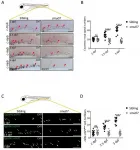(Press-News.org) Hematopoietic stem/progenitor cells (HSPCs) include hematopoietic stem cells and several lineage-biased hematopoietic progenitor cells, which can provide all blood cell types in an adult organism. Among them, hematopoietic stem cells have the ability of self-renewal and multi-lineage differentiation, and can rapidly respond under acute hematopoietic conditions. Meanwhile, the hematopoietic progenitor cells can maintain the supply of blood cells in homeostatic hematopoiesis. In a word, HSPCs are the core of the blood system, once their homeostasis is destroyed, it will lead to serious blood diseases and even death. Therefore, the researches associated with the HSPCs can provide a strong support for relevant theoretical studies and clinical treatments.
In order to study the development of the hematopoietic system, researchers often utilize zebrafish as a model, which has the advantages of short growth cycle, large amount of transparent eggs, in vitro fertilization of embryos, easy access to gene editing, and so on. In addition, the hematopoietic system of zebrafish is highly conserved to that of human, which is also the basis for the application of zebrafish in hematopoietic researches.
Back in 2012, Wenqing Zhang's research group and Yiyue Zhang's research group collaboratively carried out forward genetic screening of zebrafish, inducing random gene mutations in zebrafish through compound ENU, and obtaining a series of zebrafish mutants with hematopoietic defects. Based on this research, the cooperation team continues to explore these mutants, digging deeper into which genes are mutated and through which mechanisms these genes cause defects in the hematopoietic system.
Recently, a new research paper of Yiyue Zhang's lab and Wenqing Zhang's lab, named as "Slc20a1b is essential for hematopoietic stem/progenitor cell expansion", was published in SCIENCE CHINA Life Sciences. This study revealed that a point mutation of zebrafish slc20a1b gene can significantly reduce the proliferation of HSPCs, resulting in a severe defect of hematopoietic development.
In this research, the researchers first conducted a more in-depth phenotypic identification of the smu07 mutant, obtained by the previous ENU mutagenesis. The hematopoietic defects of the erythroid, myeloid, and lymphoid lineages of the mutant were all present, suggesting that the upstream HSPCs may have been defected. Further investigation showed that the mutant's HSPCs could be produced normally at the initial stages, but then failed to expand continuously, and the number of HSPCs was significantly lower than that of normal zebrafish (Figure 1).
Next, the researchers performed genetic mapping of the mutation site and identified the causative gene to be slc20a1b, in which a single DNA base mutation caused a single amino acid mutation in its protein (D48E).With the help of CRISPR-Cas9 technology, they constructed an additional slc20a1b mutant, which phenotype was identical with the smu07 mutant, verifying that the gene causing the mutation was indeed slc20a1b.
Since slc20a1b is a widely expressed gene, the researchers further explored whether genetic mutations in HSPCs were responsible for its phenotype, or whether other cells in its niche played a dominant role. They found that the mutant HSPCs were unable to expand in a normal environment, while the wild-type HSPCs were able to expand in the mutant environment. This result proved that the defect was caused by the autonomous mutation of the slc20a1b gene in HSPCs.
Finally, the researchers investigated the cellular mechanism of the HSPC defects and found that the cell death of mutant HSPCs remained unchanged, but the defect of its proliferation ability prevented the HSPCs from being expanded. The cell cycle of mutant HSPCs was blocked in the G2/M phase and thus could not complete the normal proliferation cycles.
In summary, the authors found that slc20a1b mutant HSPCs autonomously developed an expansion defect, which is featured by cell cycle arrest leading to decreased proliferation (Figure 2), resulting in a severe deficiency of HSPCs and all hematopoietic lineages.
This study is the first to report the indispensable role of slc20a1b gene in HSPCs, revealing a novel regulation gene of the cell cycle of HSPCs.
INFORMATION:
Jiakui Chen from Southern Medical University and Dr. Gaofei Li from South China University of Technology are the co-first authors of this research. Dr. Yiyue Zhang and Dr. Wenqing Zhang, both from South China University of Technology, are the co-corresponding authors of the study. Other authors involved in this research are Dr. Junwei Lian, Dr. Zhibin Huang, Dr. Jianchao Li from SCUT, Dr. Ning Ma from SMU and Dr. Zilong Wen from HKUST.
See the article: J. Chen, G. Li, J. Lian, N. Ma, Z. Huang, J. Li, Z. Wen, W. Zhang, Y. Zhang, "Slc20a1b is essential for hematopoietic stem/progenitor cell expansion," Sci China Life Sci. (2021). doi:/10.1007/s11427-020-1878-8
https://www.sciengine.com/publisher/scp/journal/SCLS/doi/10.1007/s11427-020-1878-8?slug=fulltext
Almost all wild canines in Australia are genetically more than half dingo, a new study led by UNSW Sydney shows - suggesting that lethal measures to control 'wild dog' populations are primarily targeting dingoes.
The study, published today in Australian Mammalogy, collates the results from over 5000 DNA samples of wild canines across the country, making it the largest and most comprehensive dingo data set to date.
The team found that 99 per cent of wild canines tested were pure dingoes or dingo-dominant hybrids (that is, a hybrid canine with more than 50 per cent dingo genes).
Of the remaining ...
Irvine, Calif., March 25, 2021 -- A short-term intervention in daily fiber consumption can significantly alter the gut microbiome and nutrient intake, according to a study led by University of California, Irvine researchers. The research was recently published by the American Society for Microbiology.
Dietary fiber consists of resistant carbohydrates found in fruits, vegetables and whole grains. Fiber persists in our digestion system, and while not digestible by humans, our gut bacteria can metabolize fiber into short-chain fatty acids and other byproducts critical to human health.
Currently, the average person in North America consumes less than 50 percent of the recommended dietary ...
Water scarcity is often understood as a problem for regions experiencing drought, but a new study led by Tufts University researchers finds that not only can localized water shortages impact the global economy, but changes in global demand can have positive and negative ripple effects in river basins across the globe.
In addition to Tufts engineers, the team included experts from the Joint Global Change Research Institute at the Pacific Northwest National Laboratory, and Cornell University.
"We're finding that water scarcity dynamics are more complicated than traditionally acknowledged," said Flannery Dolan, a graduate student ...
International genomics research led by the University of Leicester has used artificial intelligence (AI) to study an aggressive form of cancer, which could improve patient outcomes.
Mesothelioma is caused by breathing asbestos particles and most commonly occurs in the linings of the lungs or abdomen. Currently, only seven per cent of people survive five years after diagnosis, with a prognosis averaging 12 to 18 months.
New research undertaken by the Leicester Mesothelioma Research Programme has now revealed, using AI analysis of DNA-sequenced mesotheliomas, that they evolve along similar or repeated paths between individuals. These paths predict the aggressiveness and possible therapy of this otherwise incurable cancer.
Professor ...
Bottom Line: Various genetic alterations in circulating tumor cells (CTCs) were associated with clinical outcomes and resistance to hormone therapy in patients with metastatic castrate-resistant prostate cancer (mCRPC).
Journal in Which the Study was Published: Molecular Cancer Research, a journal of the American Association for Cancer Research
Author: Andrew Armstrong, MD, MSc, a medical oncologist at the Duke Cancer Institute Center for Prostate and Urologic Cancers at Duke University
Background: While only a minority of men with mCRPC have primary resistance to the androgen receptor (AR) inhibitors enzalutamide (Xtandi) or abiraterone acetate (Yonsa or Zytiga), most men will ...
A study with first-time learners of Japanese has measured how brain activity changes after just a few months of studying a new language. The results show that acquiring a new language initially boosts brain activity, which then reduces as language skills improve.
"In the first few months, you can quantitatively measure language-skill improvement by tracking brain activations," said Professor Kuniyoshi L. Sakai, a neuroscientist at the University of Tokyo and first author of the research recently published in Frontiers in Behavioral Neuroscience.
Researchers followed 15 volunteers as they moved to Tokyo and completed introductory Japanese classes for at least three hours each day. All volunteers ...
March 23, 2021-- A new study published online in the Annals of the American Thoracic Society examines if the source of physician payment for a medical opinion influences whether the physician finds that a coal miner has black lung disease. The study is the first to look at this relationship in the workers' compensation process.
In "Association Between Financial Conflicts of Interest and ILO Classifications for Black Lung Disease," Lee S. Friedman, PhD, associate professor, School of Public Health, Division of Environmental and Occupational Health Sciences, University of Illinois Chicago and colleagues looked at which party reimbursed B-readers--physicians trained and licensed by the National Institute for Occupational Safety and Health (NIOSH) and approved by the U.S. ...
University of Illinois Chicago researchers are the first to report on the financial conflicts of interest that exist among doctors who review the chest X-rays of coal miners who file workers' compensation claims of totally disabling disease with the U.S. Department of Labor's Federal Black Lung Program.
The UIC researchers found that the determinations of these doctors - who are known as B-readers and who are certified by the National Institute for Occupational Safety and Health, or NIOSH - were strongly associated with the party that hired them.
By analyzing ...
X-rays, first used clinically in the late 1890s, could be a leading-edge diagnostic tool for COVID-19 patients with the help of artificial intelligence, according to a team of researchers in Brazil who taught a computer program, through various machine learning methods, to detect COVID-19 in chest X-rays with 95.6 to 98.5% accuracy.
They published their results in IEEE/CAA Journal of Automatica Sinica, a joint publication of the IEEE and the Chinese Association of Automation.
The researchers have previously focused on detecting and classifying ...
The uneven distribution of school closures in the US since September 2020 threatens to exacerbate regional, racial and class-based divides in educational performance, according to research by Zachary Parolin, of Bocconi University's Department of Social and Political Science, recently published in Nature Human Behavior. For example, in October, only 35% of White students were on distance learning, compared with 52% of Black students, 60% of Hispanic students and 65% of Asian students. And schools recording the lowest math scores were 15% more likely to be closed.
Professor Parolin and Emma Lee (Columbia University) found in fact that exposure ...




